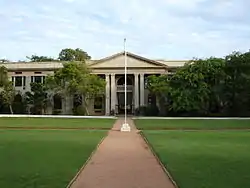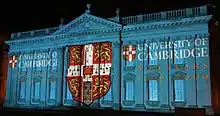D. R. Wijewardena
Don Richard Wijewardena (Sinhala:දොන් රිච්ඩ් විජෙවර්ධන) (23 February 1886 – 13 June 1950) was a Sri Lankan press baron who was a leader in the Sri Lankan independence movement. A successful entrepreneur, he established Lake House newspapers and played a major role in the independence movement.
Don Richard Wijewardana | |
|---|---|
.jpg.webp) | |
| Personal details | |
| Born | Don Richard Wijewardana 23 February 1886 Ceylon |
| Died | 13 June 1950 (aged 64) |
| Nationality | Ceylonese |
| Spouse(s) | Alice Meedeniya |
| Children | Two sons and Three daughters |
| Parents | Don Philip Wijewardana (Father) Helena Weerasinghe (Mother) |
| Residence | Rickman House, Arcadia |
| Alma mater | S. Thomas' College, Mutwal University of Cambridge |
| Occupation | Press Baron |
| Profession | Barrister |
| Known for | Lake House |
| Military service | |
| Allegiance | Ceylon |
| Branch/service | Ceylon Defence Force |
| Years of service | 1915-1917 |
| Rank | Lieutenant |
| Unit | Ceylon Light Infantry |
Early life and education


.svg.png.webp)
D. R. Wijewardena was born as the third male child of seven sons and two daughters of Muhandiram Tudugalage Don Philip Wijewardene, a timber merchant of Sedavatta, Colombo and Helena Weerasinghe. He lost his father at a very young age and was raised by his mother. His brothers were Don Philip Alexander, Don Lewis, Don Charles, Don Edmund, Don Albert and Don Walter and his sisters were Harriot who married Dr Arthur Seneviratne and Agnes Helen who married Justice Eugene Wilfred Jayewardene.
Wijewardena received his primary education at the Sedavatta School after which like all his brothers, completed his secondary education at St.Thomas College Mutwal.[1][2][3]
He then went on to study at Peterhouse, Cambridge. There he developed his interest in politics and met famous personalities such as future leaders of India like Lala Lajpat Rai, Bepin Chandra Pal, Surendranath Banerji and Gopal Krishna Gokhale. After graduating he became a Barrister at the Inner Temple.
Legal practice
Returning to Ceylon in 1912, he took oaths as an Advocate of the Supreme Court of Ceylon and started his legal practice at Hulftsdorp. He did not practice law for long, turning towards business activities instead.
Military service
Wijewardena gained a commission as a Second Lieutenant in the Ceylon Light Infantry a volunteer unit in 1913. Mobilized for war service during World War I, he served as a Lieutenant until resigning in 1917 on grounds of principle after he was reprimanded by his commanding officer for inviting legislative council member O. C. Tillekeratne for dinner at the officer's mess at the Echelon Barracks.[4]
Press Baron
In 1914, he acquired the Sinhala language daily Dinamina in 1914 together with his brother D. C. Wijewardena. He thereafter in 1918 bought the English language daily The Ceylonese from Sir Ponnambalam Arunachalam for Rs 16,000, renaming it the Ceylon Daily News and bought its primary competition Ceylon Independent. This was followed by the publication of a Tamil language daily Thinakaran. In 1923, he purchased The Observer which had been founded in 1834. In 1926, these newspapers where consolidated under Associated Newspapers of Ceylon Limited (ANCL) which would publish seven newspapers Dinamina, Silumina (Sinhalese) Daily News, the Observer, Sunday Observer (English), Thinakaran and Sunday Thinakaran (Tamil). ANCL shifted its operations to a purpose-built building along the banks of the Beira Lake, which was called Lake House from which he derived the name of the holding company Lake House Group owned by Wijewardena which brought together his different publications which included the Fergusons Ceylon Directory.[5]
Nationalist movement
In 1913, Wijewardena was elected Secretary of the Ceylon National Association, marking his formal entry into politics and together with its President Sir James Peiris he agitated for constitutional reform and self-rule.[6]
D. R. Wijewardena and E. W. Perera traced the location of the banner of last King Sri Vikrama Rajasinghe, the last king of the Kingdom of Kandy to the Royal Hospital Chelsea where it was kept since the surrender of the Kingdom to the British in 1815. The recovered banner became a focal point in the independence movement and it became the flag of the Dominion of Ceylon upon its independence in 1948.[7]
Wijewardena was in touch with local events and organised the first deputation to the Secretary of State for the Colonies with H. J. C. Pereira along with E. W. Perera. As a result of lobbying benefits Ceylonese were given another concession of a seat in the British dominated Legislative Council of Ceylon. To this seat majority of the Ceylonese elected Sir Ponnambalam Ramanathan against Sir (Dr) Marcus Fernando. He would later organise a second deputation too. He was also instrumental in starting the Temperance movement and the Amadyapa Sabha.
Family
He married Alice Gertrude Ruby Meedeniya in 1916, she was the daughter of Meedeniya Adigar. They had two sons and three daughters, his grandson Ranil Wickremasinghe would later become Prime Minister of Sri Lanka.[8] His brother-in-law was Sir Francis Molamure, the first speaker of the State Council and his nephew (Helen's son) was J. R. Jayewardene, President of Sri Lanka.
Legacy
The Associated Newspapers of Ceylon Limited he established played a major role in the pre and post independence era becoming a powerful media influence in Ceylon, resulting its taken over by the government under the Associated Newspapers of Ceylon Limited (Special Provisions) Law No. 28 of 1973 and remains to this day the government owned print media publishing house. A strong proponent for a university in Ceylon, he is one of the founders of the University of Ceylon[9] and one of its residence hall was named Wijewardena Hall in his honor. He bequeathed a large number of Buddhist books to the university library and funded several scholarships. McCallum Road in Colombo was renamed D.R.Wijewardena Mawatha.[5]
See also
References
- "D. R. Wijewardene – trail blazer in local newspaper industry". Archived from the original on 3 July 2013. Retrieved 28 May 2013.
- "121st birth anniversary of D. R. Wijewardene falls today: Lake House and D. R. Wijewardene: The informative and the pragmatist". Archived from the original on 3 July 2013. Retrieved 28 May 2013.
- "Old Thomians who rallied round the boss". Archived from the original on 14 July 2014. Retrieved 28 May 2013.
- D.R. rises to the occasion
- "D.R. Wijewardene: Trailblazer of the Lankan publishing industry". Daily News. Retrieved 2 February 2021.
- Working towards reform, The Sunday Times (Sri Lanka) Retrieved 23 April 2015
- Tribute to the men who gave us the National Flag
- DEP Franz – Family #3084
- "University of Peradeniya 1954" (PDF). pemsaa.uk. Peradeniya Medical School Alumni Association of the United Kingdom. Retrieved 2 February 2021.
External links